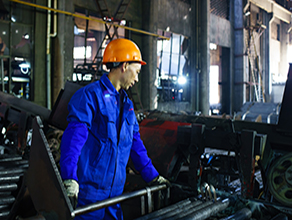
In the selection of industrial materials, alloy seamless steel tubes and carbon steel seamless steel tubes are two commonly used types of tubular products, exhibiting significant differences in performance, scope of application, and cost-effectiveness. A correct understanding of the distinctions between these two seamless steel tubes is crucial for ensuring equipment safety and optimizing procurement costs.
Fundamental Differences in Material Composition
Carbon steel seamless steel tubes primarily consist of iron and carbon as basic elements, with carbon content typically ranging from 0.06% to 1.5%. Depending on the carbon content, they can be further classified into low-carbon steel, medium-carbon steel, and high-carbon steel. The presence of carbon significantly enhances the strength and hardness of the steel, but excessive carbon content reduces the material's plasticity and toughness.
In contrast, alloy seamless steel tubes incorporate alloying elements such as chromium, molybdenum, nickel, and vanadium added to the carbon steel base. The addition of these elements not only improves the mechanical properties of the material but also imparts special physical and chemical characteristics. For example, chromium enhances corrosion resistance, molybdenum improves high-temperature strength, and nickel enhances low-temperature toughness.

Significant Differences in Mechanical Properties
In terms of mechanical properties, alloy seamless steel tubes demonstrate clear advantages. Through rational alloy design and heat treatment processes, the yield strength of alloy seamless steel tubes can reach over 500 MPa, and the tensile strength can exceed 700 MPa, far surpassing the levels of ordinary carbon steel seamless steel tubes. Simultaneously, alloying elements also improve the material's toughness and lower its ductile-to-brittle transition temperature.
Although carbon steel seamless steel tubes have lower strength, they possess good plasticity and formability. Their yield strength typically ranges between 245-345 MPa, and tensile strength is around 400-500 MPa, fully meeting the requirements for general industrial applications.
Comparative Analysis of Temperature Resistance
In high-temperature environments, alloy seamless steel tubes exhibit superior performance advantages. Chromium-molybdenum alloy seamless steel tubes maintain good strength and microstructural stability at temperatures above 500°C, making them widely used in high-temperature equipment such as boilers and heat exchangers. In contrast, carbon steel seamless steel tubes show a significant decrease in strength when temperatures exceed 350°C.
For low-temperature service conditions, nickel-containing alloy seamless steel tubes offer excellent low-temperature toughness, making them suitable for cryogenic environments like liquefied natural gas (LNG) storage and transportation. Carbon steel seamless steel tubes are prone to brittle fracture at low temperatures, thus their use in low-temperature applications is limited.
Differences in Corrosion Resistance
The addition of alloying elements significantly enhances the corrosion resistance of seamless steel tubes. Stainless steel seamless tubes, leveraging the passive film formed by chromium, can resist corrosion from various media; weather-resistant steel seamless tubes greatly improve corrosion resistance in atmospheric environments through the combined action of elements like copper and phosphorus.
Carbon steel seamless steel tubes have relatively poor corrosion resistance and usually require protective measures such as coatings or platings during use.
Machining and Welding Characteristics
Carbon steel seamless steel tubes offer good machinability, being easy to cut, bend, and form using cold working operations. Their weldability is excellent, allowing high-quality welds to be achieved using conventional welding methods. These characteristics make carbon steel seamless steel tubes the most commonly used tubular material for structures.
Machining and welding alloy seamless steel tubes require special process measures. Due to the influence of alloying elements, these tubes often require preheating and post-weld heat treatment during welding to prevent the occurrence of cold cracks.
Cost-Benefit Analysis
From a procurement cost perspective, carbon steel seamless steel tubes have a clear advantage, typically being 30% to 50% cheaper than alloy seamless steel tubes of the same specification. However, from a life-cycle cost analysis, using alloy seamless steel tubes in demanding service conditions is often more economical, as their longer service life and lower maintenance costs can offset the initial investment difference.
Changzhou Tenjan Steel Tube Co., Ltd. recommends that users comprehensively consider factors such as the service environment, design life, and maintenance costs to select the most cost-effective seamless steel tube material. The company provides professional technical and economic analysis services to help customers optimize material selection plans.
Selection Recommendations for Application Fields
Carbon steel seamless steel tubes are widely used in general service areas such as building structures, general fluid transport, and low-pressure equipment. Their good overall performance and lower cost make them the highest volume variety of seamless steel tubes.
Alloy seamless steel tubes are primarily used for special service conditions including high-temperature and high-pressure equipment, corrosive environments, and low-temperature engineering. In critical sectors such as petrochemicals, power station boilers, and aerospace, alloy seamless steel tubes are indispensable key materials.

Conclusion
Alloy seamless steel tubes and carbon steel seamless steel tubes each possess unique performance characteristics and application fields. Correctly selecting the seamless steel tube material requires comprehensive consideration of factors such as service conditions, performance requirements, and economic factors. Relying on its extensive product range and professional technical services, Changzhou Tenjan Steel Tube Co., Ltd. can provide customers with optimal material selection advice and product solutions.
For more technical information on seamless steel tube selection or to request product samples, please feel free to contact Changzhou Tenjan Steel Tube Co., Ltd. We are committed to providing you with the most suitable seamless steel tube products through our professional expertise and high-quality service.
Contact Phone: 0519-88789990
Official Website: https://www.tenjan.com/
Home Product Capabilities Case Studies Blogs About Get a Quote
Pipe & Tube Manufacturing Process Shapes & Profiles Pipes & Tubes Material Standard Steel Pipes & Tube Rebar Couplers Cold Drawn Steel Profiles & Bars
Oil & Petrochemical Industry Automotive & Motorcycle Components Mechanical Engineering Components Mining Construction Support Structures High-Pressure Boiler System Construction Machinery Geological Drilling Agricultural Machinery Parts Industrial Fluid Transfer Systems
© 2024 Changzhou Tenjan Steel Tube Co., Ltd All rights reserved. Privacy StatementTerms-ConditionsSitemap